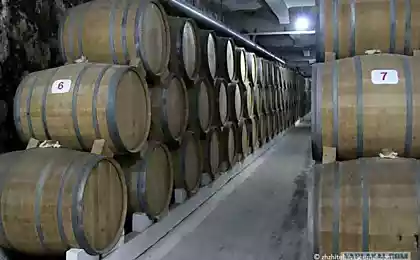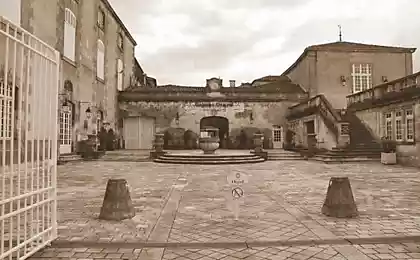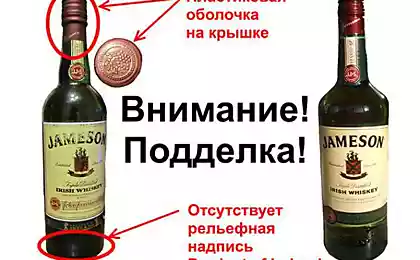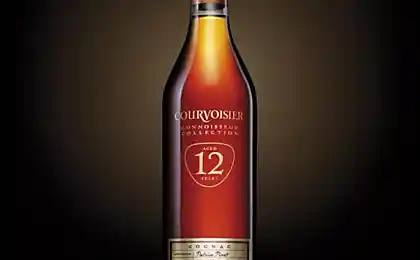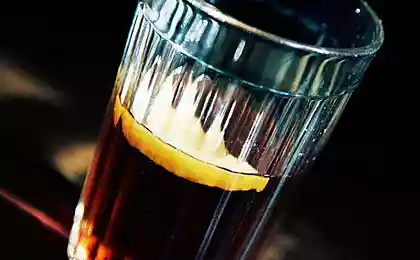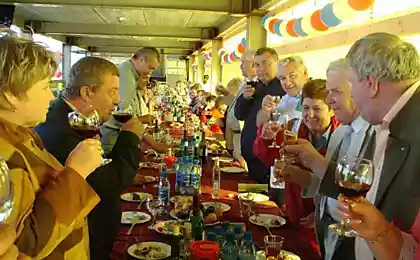1058
How is the brandy
During the tour of the Poitou-Charentes region and explore the various cognac houses, we talked a lot about the history of the drink, and the technology of its production, with part of the information received was for me absolutely new. This post will talk about how to make brandy and cognac houses of concrete will be other individual records.
Yes, and then explains how to make Italian grappa ...
The fact causing the drink has appeared as such, I have heard several legends. The most common stated that in the region of Cognac in any year was a significant overproduction of wine, and then some kind of king (or marquis or baron) decided to try to overtake the excess, in order to see what happens. Surpass, got brandy spirit, tried - and was so excited that that since only brandy and ate.
So, this idiotic story has nothing to do with reality.
22 photos via exler

As you know, Goldmember did not like people intolerant to a foreign culture, and Dutch. And in vain, because it is the Dutch were the first to make brandy - the drink produced by the process of distillation (distillation) of wine.
Even in the XIII century Dutch explorers sailed in the Charente region and bought it salt and wine. And they bought a lot of wine, and it makes the wine industry in the region to develop very actively. The city of Cognac, which is in the XI century was known as the largest exporter of salt, it has also become a major exporter of wine.
However, the more produced, the greater the quality of wine has fallen: in particular, the percentage of alcohol fell. These wines are poorly tolerated sea trips and quick port. Then the bold experimenters, the Dutch began to make "burnt wine» (brandwijn - this word came the word of brandy) - Brandy is distilled wine into alcohol. This alcohol can be transported and stored for a long time, but the idea and then dilute it to get the original wine - was wrong. Nevertheless, the brandy is produced and transported - wine and it still did not really get off.
French when it became clear that the Dutch are willing to buy cognac alcohol than wine, too, began to engage in distillation to offer the Dutch finished product.
At the beginning of the XVII century, manufacturers have found that the double distillation gives much better the brandy (in French cognac spirit sounds like eau de vie - «eau-de-vie"), which could very well be transported and stored for a long time. And then did the case helped: cargo was so large that cognac alcohol for a long time stood in warehouses in oak barrels, waiting for loading, and at some point, manufacturers realized that aging in oak barrels for a very positive effect on the taste of the drink, which became possible may consume in its pure state, without water dilution.
Here with these times in the Poitou-Charentes region, where the city of Cognac, and became actively develop the production of cognac, which is technologically consists of several stages.
- The cultivation of grapes of certain varieties;
- Vintage, getting under the pressure of grape juice;
- Fermentation of grape juice - that is, getting the wine;
- Double-distilled wine, middle fractions separation ("heart") in order to - produce high-quality cognac spirit;
- Primary alcohol exposure in new French oak barrels;
- Long-term exposure of alcohol in old barrels;
- Assemblage (blending) various alcohols and diluted with water to obtain a standard fortress;
- Bottling.
All these steps, as well as in the production of French wine, very strictly regulated by government decree, and for the strict observance of the established rules of the following special organizations that can not only deprive the license of the manufacturer, allows himself some liberties, but also put him in jail precedent It was one such talk later.
Now let's look at these steps in more detail.
Growing grapes and wine production
For the production of brandy is not suitable any wine. The best results are obtained when the distilled wine, created from sour grapes containing a minimum amount of sugar (winemakers say - "containing the minimum quantity of alcohol," which technically is not quite right, because the sugar is converted into alcohol only as a result of the fermentation process). The main variety used for the production of brandy, called Ugni Blanc (Ugni Blanc). It is also valued for its good resistance to all kinds of grape diseases. By the way, this variety in the region came after the famous epidemic of phylloxera of 1870, which destroyed most of the vineyards of Europe. Until this year, the brandy made from varieties Folle Blanche, Colombard and Montilla. (In Italy, the variety Ugni Blanc and Trebbiano called there because of this sort make white wine.)
Also used as Ugni Blanc varieties Folle Blanche and Colombard, but to a much lesser extent.

3.
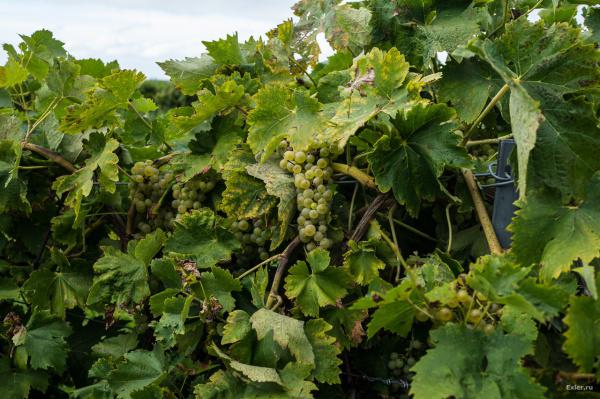
4.
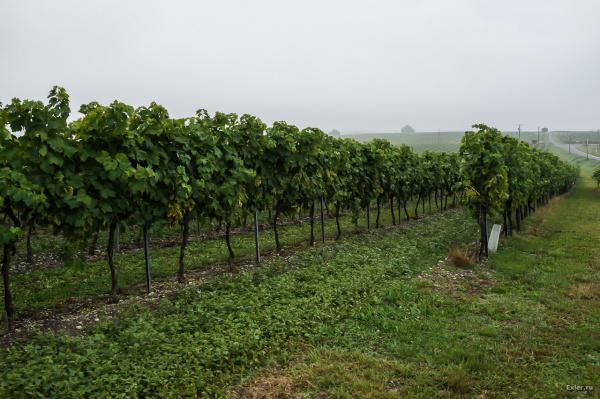
5. Grape harvesting is done manually or by means like these tractors. But mostly - manually, because charge on a tractor significantly lower quality of the resulting product.

6.
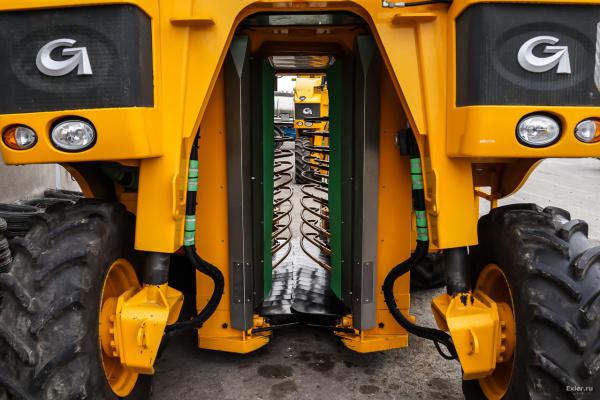
7. After harvesting the grapes allowed under the press, and the use of traditional media with the Archimedean screw - is strictly forbidden (due to the low quality of the wort). It uses horizontal and more modern pneumatic presses. (By the way, in the production of wine and many farms switched to pneumatics.)
Then fermentation begins - that is, the production of wine.
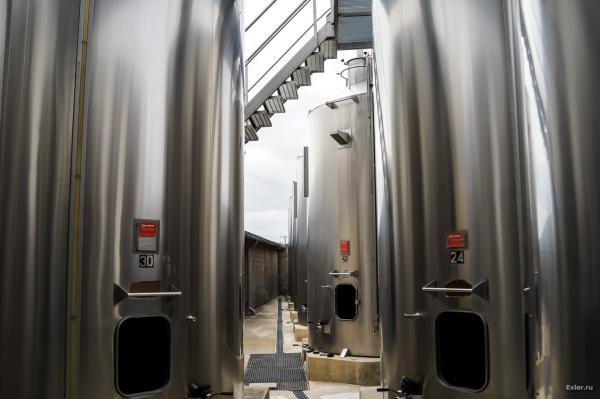
8. Distillation
Approximately looked old apparatus for distillation.
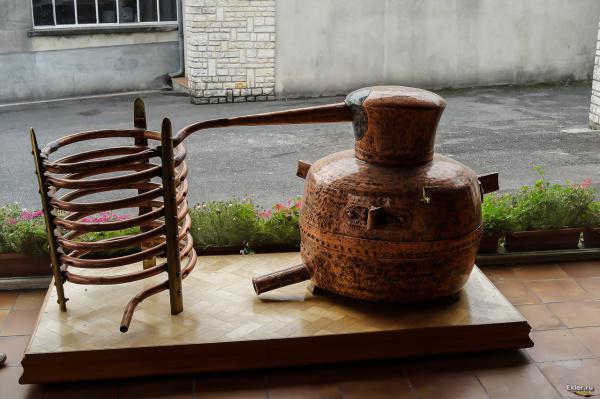
9. By contrast, modern apparatus for distillation of cognac in all farms appear the same, because there is only Charentaise alembic original form.
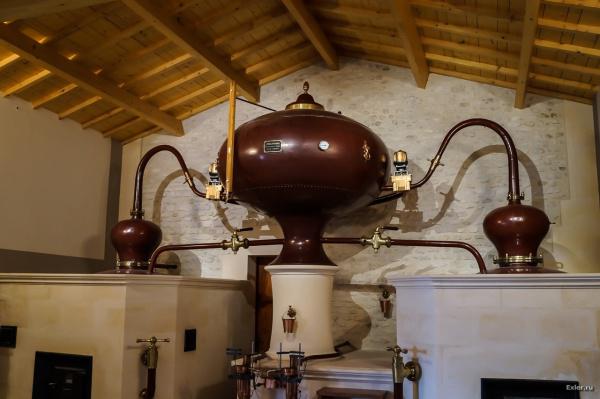
10. In some houses these cubes can be 3-5, in others - tens.
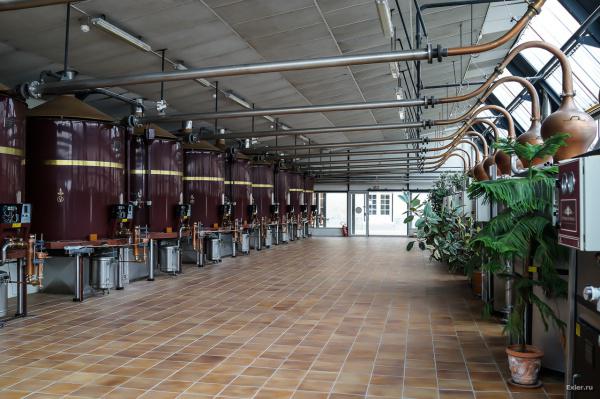
The process of double distillation - is very difficult. In the first stage unfiltered white wine, bring to a boil, alcohol vapors rise to the top in the cap of the distiller, pass through the tube and kondentsiruyutsya in the cooling system. Thus obtained crude alcohol (in French - brouillis). Next, the resulting liquid is subjected to distillation in a second distillation secondary boiler. Moreover, the capacity of the boiler may not exceed 30 hectoliters.
At this stage the crucial work of specialists in the distillation, because in the course of the second distillation must be able to cut off a fraction of the median - the so-called "heart" - from primary and tertiary faction, called the "head" and "tail».
Incidentally, distillation is always carried out before March 31 - a purely statutory.
The primary exposure
Primary extract brandy produced exclusively in French oak barrels, and for the manufacture of the barrels are allowed to use only two types of oak: growing in forests Limousin and forests Tronse.
Cooperage boards made from oak barrels, which at least 100 years. Further, these boards are kept for three years in the fresh air - to clean up the juice. Thereafter, the workpiece is formed in a certain way, and then Cooper begins to assemble the barrel and its firing of oak shavings. Heating need for "shrinkage" boards, and aged in barrels make certain alcohols taste.
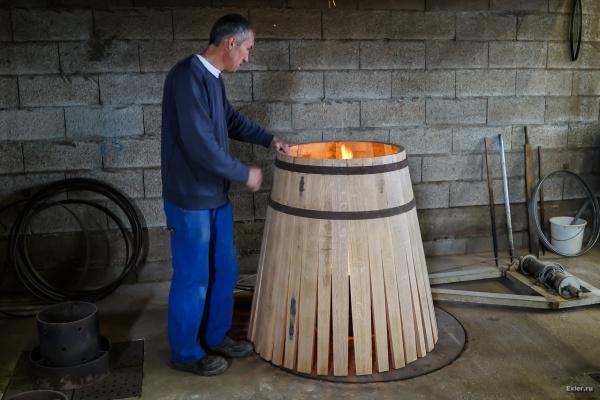
12.
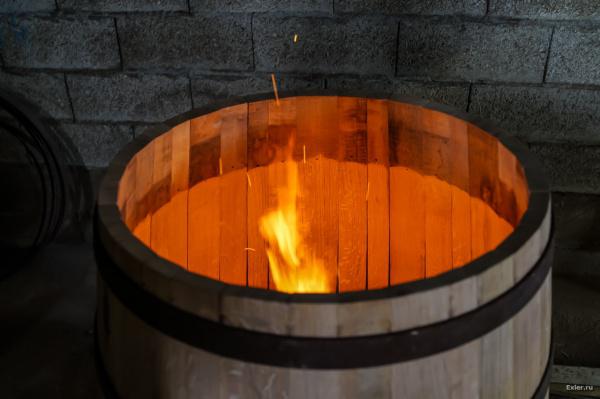
13. Exposure cognac consists of three stages: extraction was (penetration of components of wood alcohol), hydrolysis (the change of the properties and preparations for the "digestion of wood") and oxidation (color saturation becomes, new flavor notes).
The barrels are stored at a specific temperature and humidity. For primary aging barrels used no more than five years.

14.
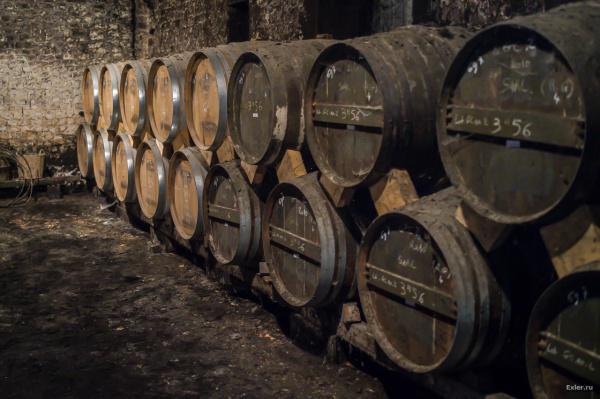
Prolonged exposure
When cognac, according to experts, peak exposure, it is placed in an old barrel, where he was "resting." Place in the store, where the most seasoned spirits, called "paradise" or "heaven".
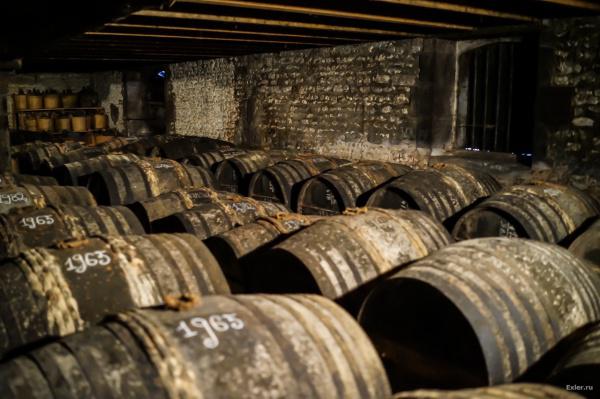
16. Traditionally, the cellars does not fight with the spiders is believed that they kill animals that can damage the barrel.
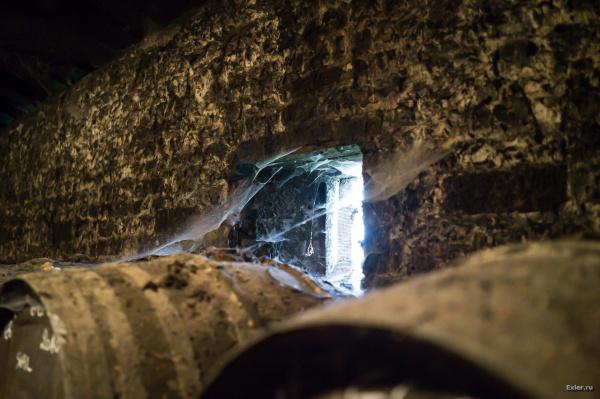
In the process of alcohol exposure gradually loses its castle: originally a secondary alcohol distillation has a fortress of 65-70%. After holding it will be a fortress of 42-50 degrees.
It is also in the process of being in barrels alcohol evaporates gradually losing somewhere in the 2% per year. Cognac fifty excerpts loses about half of its volume. These losses are usually referred to as "share of the angels." And the angels get a good share: about 24 million standard bottles a year, if you count the total amount of production of cognac.
After aging in old oak barrels cognac alcohol can be placed in special glass vessels called "demi-zhonami» (Dames-Jeanne). They can be stored alcohol decades (if not centuries), not changing their properties.
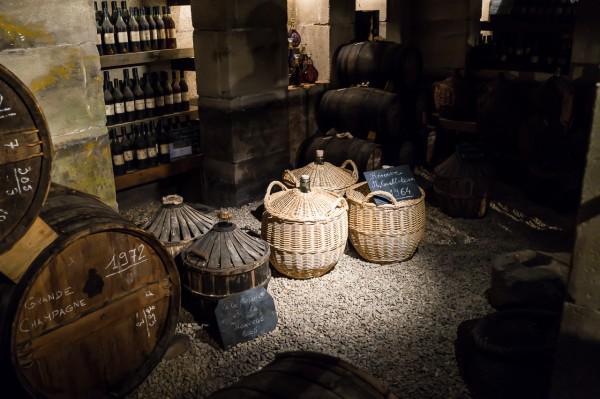
Assemblage
On the basis of several seasoned alcohols done assemblage: mixing alcohols in different proportions to get a certain brand.
Furthermore, for bringing brandy to finished form in an alcohol, usually gradually added distilled water: beverage strength corresponded to the set parameters.
Also on stage assemblage of brandy can be added to the sugar and caramel. It is legally allowed. Although the caramelization is not particularly welcome, as a cheap way to get a specific taste. We speak every cognac house proudly caramelization do not use. But almost all the rest - is used. Well, almost everyone else says the same thing: here they are - there is, and all the rest - yes.
In short, bodyazhat, as they want!
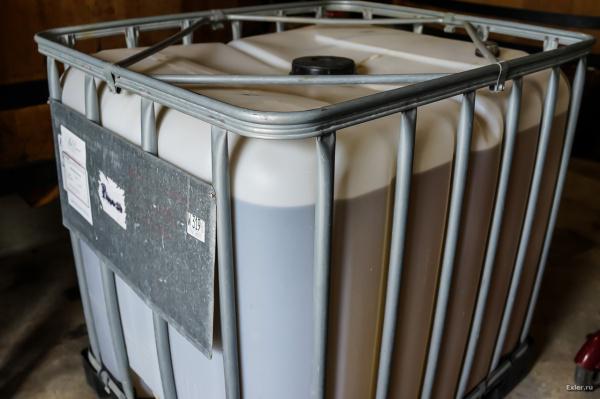
19. That in such barrels made mixing different alcohols and topping up with water. And topping up is very slow and very gradually, in a certain portion of a year.
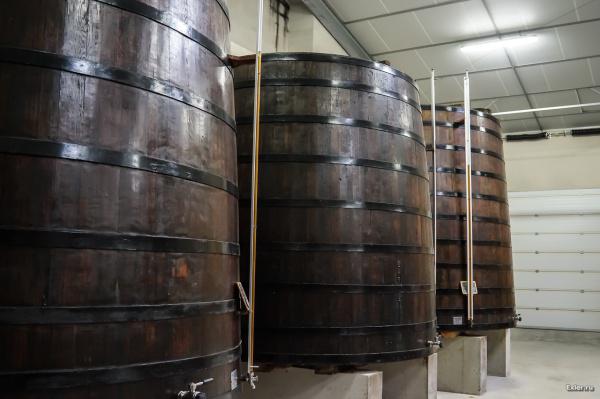
20. Small cognac houses that make their own full production cycle, distilled water pre-soaked in barrels of wine: it is believed that it is at a dilution of alcohol produces a more interesting and smooth taste. Farms that do not produce wine, using ordinary distilled water.
And finally there is cognac, which was then bottled.
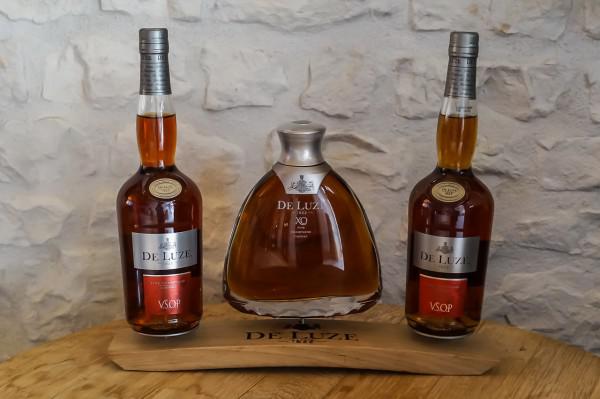
As I said, brandy production at all stages of a very highly regulated and controlled. No experiments are not allowed - even if not intended for cognac sales. In one of the cognac houses, we were told the terrible story of a bold experimenter who in the process of aging cognac tried to mix a drink in the oak chips - to achieve a more pronounced flavor. It immediately one of its employees stukanula in Cognac Police the night to the guy on the production broke "Mask Show", found a violation of the technology - and the guy specifically landed in jail for five years, despite the fact that selling the brandy he did not going. Plus, he was deprived of the license, which is much worse. Seriously, we have the story told is not an anecdote.
And as all the production plants are tested and certified (eg, you can not use the distiller unconventional forms) and millezimnye grade (this brandy made from cognac spirit only one year - we are about it later we say) even further every year checked special expert and plug barrels of cognac millezimnyh sealed.
About the name
As we know, can only be called cognac drink produced in the Poitou-Charentes region as a result of a strictly regulated process of distillation of certain wine grapes grown in certain cru (there are six) in the region.
No other drinks, even if they are made in a different place on the relevant technology from grapes grown in one of the six crus, cognac can not be called - they are called brandy.
Thus, the Russian cognac, Armenian brandy, cognac and Georgian Kryzhopolsky brandy - all relevant brandy, and not brandy.
The network has mentioned that in the history of the one and only foreign manufacturer was allowed to write «Cognac» on the label - the famous Nikolai Shustov, owner cognac plants in Odessa and Yerevan. I asked about the owners of cognac houses - I was told that this is impossible and can not be in principle.
But I have rummaged - it turned out that there was a scandal. Shustov somehow (well, that is a clear deception) managed to push through its own brand for the World Exhibition of 1900 in Paris. He had no right to do that because the competition involved only cognacs. However, there Shustov Brandy took first place. When everything turned out, the French came to the indescribable fury: the competition cognac won some brandy, rub maman! And in order to hush up the scandal, decided to allow Shustov to write his brandy Cognac. Well, that was a winner all the same cognac, brandy and not know it.
Incidentally, such a right at the Yerevan Cognac not: they are allowed to write "cognac" only in Russian (Russian here on the French do not care), and for the foreign market Armenian cognac referred to Armenian brandy.
Legend
Now, about the notation. There are regulated by the traditional notation minimum period of aging cognac. They are divided into the following main categories:
V.S. - Exposure of at least two years.
VSOP, Reserve - an extract of at least four years.
VVSOP, Grande Reserve - at least five years.
XO, Napoleon - delay of at least six years.
It should be borne in mind that for blends (mixtures of different alcohols) always shows the youngest alcohol.
Also interesting is the fact that different manufacturers under the standard notation can mean much more exposure than the minimum. For example, some small XO cognac houses - Thirty is the cognac and more exposure. A V.S. - Twelve.
The region has about 20 thousand cognac houses. (This is for those who believe that there is only the cognac Courvoisier, Hennessy, Martell, Rémy Martin and Camus.)
However, in reality there is now in the region of about 5000 manufacturers (not so long ago, there were 15,000), and not all of them make a complete cycle. And by "not all" means "almost nobody" because at the moment the full cycle (grapes, wine, distillation, aging, assemblage) made only 12 farms! All others specialize in certain procedures, and buy raw materials on the side. Moreover, the same major cognac houses are often distillation done in other households. And they themselves are engaged by holding, assemblage and promotion.
And because it just turns out that a small producer cognac with a complete cycle can be better, and cheaper large brandy cognac house. Quality - because it can water for dilution to insist in a barrel of wine, the distillation process makes it more difficult (in terms of raw material), but higher quality, and of advertising small producers very much not being made, and it also affects the price.
What to drink
Traditionally, drinking brandy from a large pot-bellied glasses, warming the glass in his hand, but in recent years fashion has changed. For cognac now use small narrow glasses (often - with opening to the side neck), similar to the smaller glasses for champagne. Now it is considered that it makes no sense to concentrate the rich smells of brandy in a large pot-bellied glass - say, from a little more subtle scent turns.
Well, from the giant portions of 50-100 grams of cognac went to 20 grams - they say, and that's enough. I think that in ten years serving brandy will be to examine under a microscope. He looked - be satisfied.

Serve strictly cognac room temperature. It is not heated and even more so - not cool. Stir brandy, as they do with wine, it is not recommended: the sudden evaporation of cognac alcohol can burn your nose.
How to drink and the snack
How can drink cognac? As a rule, it is drunk as an aperitif, or vice versa - as a digestif. Also brandy is often used in cocktails, and some manufacturers have a brand designed specifically for cocktails.
The best score of cognac - a coffee and cigar. As well as snacks are a variety of desserts (eg, apple charlotte) and fruits.
Of course, the traditional Soviet lemon - the worst snack for brandy, to the devil kills all its flavor. Fashion, this went from Nikolai II, which simply nothing else on hand at the time was not, as in Soviet times, the tradition of cognac snack lemon, as well as to keep the drink in the fridge, dispersed everywhere. All
Source:
Yes, and then explains how to make Italian grappa ...
The fact causing the drink has appeared as such, I have heard several legends. The most common stated that in the region of Cognac in any year was a significant overproduction of wine, and then some kind of king (or marquis or baron) decided to try to overtake the excess, in order to see what happens. Surpass, got brandy spirit, tried - and was so excited that that since only brandy and ate.
So, this idiotic story has nothing to do with reality.
22 photos via exler

As you know, Goldmember did not like people intolerant to a foreign culture, and Dutch. And in vain, because it is the Dutch were the first to make brandy - the drink produced by the process of distillation (distillation) of wine.
Even in the XIII century Dutch explorers sailed in the Charente region and bought it salt and wine. And they bought a lot of wine, and it makes the wine industry in the region to develop very actively. The city of Cognac, which is in the XI century was known as the largest exporter of salt, it has also become a major exporter of wine.
However, the more produced, the greater the quality of wine has fallen: in particular, the percentage of alcohol fell. These wines are poorly tolerated sea trips and quick port. Then the bold experimenters, the Dutch began to make "burnt wine» (brandwijn - this word came the word of brandy) - Brandy is distilled wine into alcohol. This alcohol can be transported and stored for a long time, but the idea and then dilute it to get the original wine - was wrong. Nevertheless, the brandy is produced and transported - wine and it still did not really get off.
French when it became clear that the Dutch are willing to buy cognac alcohol than wine, too, began to engage in distillation to offer the Dutch finished product.
At the beginning of the XVII century, manufacturers have found that the double distillation gives much better the brandy (in French cognac spirit sounds like eau de vie - «eau-de-vie"), which could very well be transported and stored for a long time. And then did the case helped: cargo was so large that cognac alcohol for a long time stood in warehouses in oak barrels, waiting for loading, and at some point, manufacturers realized that aging in oak barrels for a very positive effect on the taste of the drink, which became possible may consume in its pure state, without water dilution.
Here with these times in the Poitou-Charentes region, where the city of Cognac, and became actively develop the production of cognac, which is technologically consists of several stages.
- The cultivation of grapes of certain varieties;
- Vintage, getting under the pressure of grape juice;
- Fermentation of grape juice - that is, getting the wine;
- Double-distilled wine, middle fractions separation ("heart") in order to - produce high-quality cognac spirit;
- Primary alcohol exposure in new French oak barrels;
- Long-term exposure of alcohol in old barrels;
- Assemblage (blending) various alcohols and diluted with water to obtain a standard fortress;
- Bottling.
All these steps, as well as in the production of French wine, very strictly regulated by government decree, and for the strict observance of the established rules of the following special organizations that can not only deprive the license of the manufacturer, allows himself some liberties, but also put him in jail precedent It was one such talk later.
Now let's look at these steps in more detail.
Growing grapes and wine production
For the production of brandy is not suitable any wine. The best results are obtained when the distilled wine, created from sour grapes containing a minimum amount of sugar (winemakers say - "containing the minimum quantity of alcohol," which technically is not quite right, because the sugar is converted into alcohol only as a result of the fermentation process). The main variety used for the production of brandy, called Ugni Blanc (Ugni Blanc). It is also valued for its good resistance to all kinds of grape diseases. By the way, this variety in the region came after the famous epidemic of phylloxera of 1870, which destroyed most of the vineyards of Europe. Until this year, the brandy made from varieties Folle Blanche, Colombard and Montilla. (In Italy, the variety Ugni Blanc and Trebbiano called there because of this sort make white wine.)
Also used as Ugni Blanc varieties Folle Blanche and Colombard, but to a much lesser extent.

3.

4.

5. Grape harvesting is done manually or by means like these tractors. But mostly - manually, because charge on a tractor significantly lower quality of the resulting product.

6.

7. After harvesting the grapes allowed under the press, and the use of traditional media with the Archimedean screw - is strictly forbidden (due to the low quality of the wort). It uses horizontal and more modern pneumatic presses. (By the way, in the production of wine and many farms switched to pneumatics.)
Then fermentation begins - that is, the production of wine.

8. Distillation
Approximately looked old apparatus for distillation.

9. By contrast, modern apparatus for distillation of cognac in all farms appear the same, because there is only Charentaise alembic original form.

10. In some houses these cubes can be 3-5, in others - tens.

The process of double distillation - is very difficult. In the first stage unfiltered white wine, bring to a boil, alcohol vapors rise to the top in the cap of the distiller, pass through the tube and kondentsiruyutsya in the cooling system. Thus obtained crude alcohol (in French - brouillis). Next, the resulting liquid is subjected to distillation in a second distillation secondary boiler. Moreover, the capacity of the boiler may not exceed 30 hectoliters.
At this stage the crucial work of specialists in the distillation, because in the course of the second distillation must be able to cut off a fraction of the median - the so-called "heart" - from primary and tertiary faction, called the "head" and "tail».
Incidentally, distillation is always carried out before March 31 - a purely statutory.
The primary exposure
Primary extract brandy produced exclusively in French oak barrels, and for the manufacture of the barrels are allowed to use only two types of oak: growing in forests Limousin and forests Tronse.
Cooperage boards made from oak barrels, which at least 100 years. Further, these boards are kept for three years in the fresh air - to clean up the juice. Thereafter, the workpiece is formed in a certain way, and then Cooper begins to assemble the barrel and its firing of oak shavings. Heating need for "shrinkage" boards, and aged in barrels make certain alcohols taste.

12.

13. Exposure cognac consists of three stages: extraction was (penetration of components of wood alcohol), hydrolysis (the change of the properties and preparations for the "digestion of wood") and oxidation (color saturation becomes, new flavor notes).
The barrels are stored at a specific temperature and humidity. For primary aging barrels used no more than five years.

14.

Prolonged exposure
When cognac, according to experts, peak exposure, it is placed in an old barrel, where he was "resting." Place in the store, where the most seasoned spirits, called "paradise" or "heaven".

16. Traditionally, the cellars does not fight with the spiders is believed that they kill animals that can damage the barrel.

In the process of alcohol exposure gradually loses its castle: originally a secondary alcohol distillation has a fortress of 65-70%. After holding it will be a fortress of 42-50 degrees.
It is also in the process of being in barrels alcohol evaporates gradually losing somewhere in the 2% per year. Cognac fifty excerpts loses about half of its volume. These losses are usually referred to as "share of the angels." And the angels get a good share: about 24 million standard bottles a year, if you count the total amount of production of cognac.
After aging in old oak barrels cognac alcohol can be placed in special glass vessels called "demi-zhonami» (Dames-Jeanne). They can be stored alcohol decades (if not centuries), not changing their properties.

Assemblage
On the basis of several seasoned alcohols done assemblage: mixing alcohols in different proportions to get a certain brand.
Furthermore, for bringing brandy to finished form in an alcohol, usually gradually added distilled water: beverage strength corresponded to the set parameters.
Also on stage assemblage of brandy can be added to the sugar and caramel. It is legally allowed. Although the caramelization is not particularly welcome, as a cheap way to get a specific taste. We speak every cognac house proudly caramelization do not use. But almost all the rest - is used. Well, almost everyone else says the same thing: here they are - there is, and all the rest - yes.
In short, bodyazhat, as they want!

19. That in such barrels made mixing different alcohols and topping up with water. And topping up is very slow and very gradually, in a certain portion of a year.

20. Small cognac houses that make their own full production cycle, distilled water pre-soaked in barrels of wine: it is believed that it is at a dilution of alcohol produces a more interesting and smooth taste. Farms that do not produce wine, using ordinary distilled water.
And finally there is cognac, which was then bottled.

As I said, brandy production at all stages of a very highly regulated and controlled. No experiments are not allowed - even if not intended for cognac sales. In one of the cognac houses, we were told the terrible story of a bold experimenter who in the process of aging cognac tried to mix a drink in the oak chips - to achieve a more pronounced flavor. It immediately one of its employees stukanula in Cognac Police the night to the guy on the production broke "Mask Show", found a violation of the technology - and the guy specifically landed in jail for five years, despite the fact that selling the brandy he did not going. Plus, he was deprived of the license, which is much worse. Seriously, we have the story told is not an anecdote.
And as all the production plants are tested and certified (eg, you can not use the distiller unconventional forms) and millezimnye grade (this brandy made from cognac spirit only one year - we are about it later we say) even further every year checked special expert and plug barrels of cognac millezimnyh sealed.
About the name
As we know, can only be called cognac drink produced in the Poitou-Charentes region as a result of a strictly regulated process of distillation of certain wine grapes grown in certain cru (there are six) in the region.
No other drinks, even if they are made in a different place on the relevant technology from grapes grown in one of the six crus, cognac can not be called - they are called brandy.
Thus, the Russian cognac, Armenian brandy, cognac and Georgian Kryzhopolsky brandy - all relevant brandy, and not brandy.
The network has mentioned that in the history of the one and only foreign manufacturer was allowed to write «Cognac» on the label - the famous Nikolai Shustov, owner cognac plants in Odessa and Yerevan. I asked about the owners of cognac houses - I was told that this is impossible and can not be in principle.
But I have rummaged - it turned out that there was a scandal. Shustov somehow (well, that is a clear deception) managed to push through its own brand for the World Exhibition of 1900 in Paris. He had no right to do that because the competition involved only cognacs. However, there Shustov Brandy took first place. When everything turned out, the French came to the indescribable fury: the competition cognac won some brandy, rub maman! And in order to hush up the scandal, decided to allow Shustov to write his brandy Cognac. Well, that was a winner all the same cognac, brandy and not know it.
Incidentally, such a right at the Yerevan Cognac not: they are allowed to write "cognac" only in Russian (Russian here on the French do not care), and for the foreign market Armenian cognac referred to Armenian brandy.
Legend
Now, about the notation. There are regulated by the traditional notation minimum period of aging cognac. They are divided into the following main categories:
V.S. - Exposure of at least two years.
VSOP, Reserve - an extract of at least four years.
VVSOP, Grande Reserve - at least five years.
XO, Napoleon - delay of at least six years.
It should be borne in mind that for blends (mixtures of different alcohols) always shows the youngest alcohol.
Also interesting is the fact that different manufacturers under the standard notation can mean much more exposure than the minimum. For example, some small XO cognac houses - Thirty is the cognac and more exposure. A V.S. - Twelve.
The region has about 20 thousand cognac houses. (This is for those who believe that there is only the cognac Courvoisier, Hennessy, Martell, Rémy Martin and Camus.)
However, in reality there is now in the region of about 5000 manufacturers (not so long ago, there were 15,000), and not all of them make a complete cycle. And by "not all" means "almost nobody" because at the moment the full cycle (grapes, wine, distillation, aging, assemblage) made only 12 farms! All others specialize in certain procedures, and buy raw materials on the side. Moreover, the same major cognac houses are often distillation done in other households. And they themselves are engaged by holding, assemblage and promotion.
And because it just turns out that a small producer cognac with a complete cycle can be better, and cheaper large brandy cognac house. Quality - because it can water for dilution to insist in a barrel of wine, the distillation process makes it more difficult (in terms of raw material), but higher quality, and of advertising small producers very much not being made, and it also affects the price.
What to drink
Traditionally, drinking brandy from a large pot-bellied glasses, warming the glass in his hand, but in recent years fashion has changed. For cognac now use small narrow glasses (often - with opening to the side neck), similar to the smaller glasses for champagne. Now it is considered that it makes no sense to concentrate the rich smells of brandy in a large pot-bellied glass - say, from a little more subtle scent turns.
Well, from the giant portions of 50-100 grams of cognac went to 20 grams - they say, and that's enough. I think that in ten years serving brandy will be to examine under a microscope. He looked - be satisfied.

Serve strictly cognac room temperature. It is not heated and even more so - not cool. Stir brandy, as they do with wine, it is not recommended: the sudden evaporation of cognac alcohol can burn your nose.
How to drink and the snack
How can drink cognac? As a rule, it is drunk as an aperitif, or vice versa - as a digestif. Also brandy is often used in cocktails, and some manufacturers have a brand designed specifically for cocktails.
The best score of cognac - a coffee and cigar. As well as snacks are a variety of desserts (eg, apple charlotte) and fruits.
Of course, the traditional Soviet lemon - the worst snack for brandy, to the devil kills all its flavor. Fashion, this went from Nikolai II, which simply nothing else on hand at the time was not, as in Soviet times, the tradition of cognac snack lemon, as well as to keep the drink in the fridge, dispersed everywhere. All
Source:
